
The City of Mandawa was made a thikana in the mid of 18th century by the
Bhojraj Ji Kasubsub clan of Shekhawat Rajputs. About the origin of this town
there have been earlier references to Mandu Jat as founder of the Mandawa
village. He first established a dhani (hamlet) and dug a well here, which was
completed on savan badi 5 samvat 1797 (1740 AD) (source – Shekhawati Bodh,
Mandawa special issue, July 2005). Initially this place was known as ‘Mandu ki
dhani’, ‘Mandu ka bas’ or ‘Manduwas’ which changed to ‘Manduwa’, ‘Mandwa’ and
finally ‘Mandawa’.
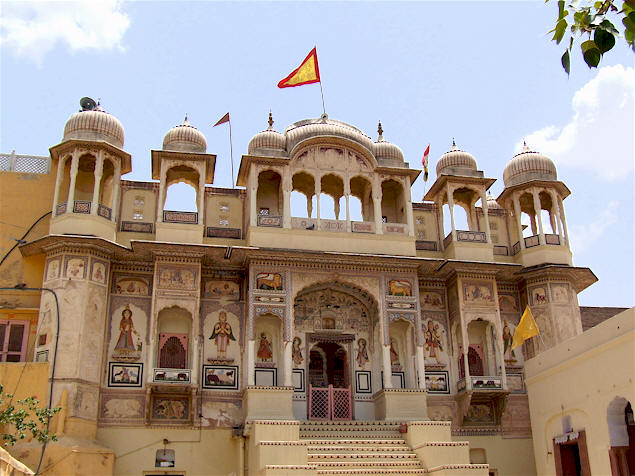
Water well near Mandawa remote feudal principality in the centre of the
Shekhawati region, Mandawa was a trading outpost for the ancient caravan routes
that stopped here from China and the Middle East. Thakur Nawal Singh, the Rajput
ruler of Nawalgarh and Mandawa, built a fort in 1755 to protect this outpost.
The township that grew around the fort soon attracted a large community of
traders, who settled here.
The fort of Mandawa was founded in the 18th century. Thakur Nawal Singh, son of
Shardul Singh, founded the fort in vikram samvat 1812 (1755 AD). The fort
dominates the town with a painted arched gateway adorned with Lord Krishna and
his cows. Built as per a medieval theme, the castle of Mandawa is adorned with
beautiful frescoes. Rooms in the palace are decorated with paintings of
Lord Krishna, exquisite carvings and amazing mirror work. The palace's Durbar
Hall houses a number of antiques and paintings.
This town has been referred to as the "open art gallery" of Rajasthan because
the entire Shekhawati region and not just Mandawa is dotted with fascinating
mansions(havelis) that have lavishly painted walls.
Hanuman Prasad Goenka Haveli
This haveli has a painting depicting Indra Dev on an elephant and Lord Shiva
on his Nandi bull.
Goenka Double Haveli
This haveli, with two gates, has a monumental façade of elephants and
horses. The outer walls, jutting balconies, alcoves and overhanging upper
storeys are replete with patterns and paintings, ranging from traditional
Rajasthani women and religious motifs to Europeans wearing stylish hats and
other Victorian finery.
Murmuria Haveli
The paintings of trains, cars, George V, and Venice were executed on the
walls of this haveli during the 1930s by Balu Ram, one of the last working
artists of the region. In pictures - like Lord Krishna with his cows in the
English courtyard and a young Nehru on a horseback, holding the national flag -
this haveli uses a unique theme blending the East with the West. The haveli also
features a long frieze depicting a train with a crow flying above the engine and
much activity at the railway crossing.
Jhunjhunwala Haveli
The haveli features a striking gold leaf painted room located to the right
of main courtyard.
Mohan Lal Saraf Haveli
A picture of a Maharaja stroking his moustaches beautifies this haveli.
Gulab Rai Ladia Haveli
This haveli is located in the south of town, where the decoration of the
outer and inner walls is perhaps the finest in Shekhawati. Blue washes here and
there betray twentieth-century censorship of the erotic scenes that had been
commonly acceptable one hundred years earlier.
The Binsidhar Newatia Haveli, Lakshminarayan Ladia Haveli and Chokhani Double
Haveli are some of the other painted havelis in the area.
Murals in the Thakurji temple, located opposite the Goenka Double Haveli and the
Murmuria Haveli, include soldiers being shot from the mouths of cannons, a
reflection of the horrors of the Mutiny of 1857. Further west are a couple of
chhatris, and a step-well, still used today and bearing paintings inside its
decorative corner domes.

|
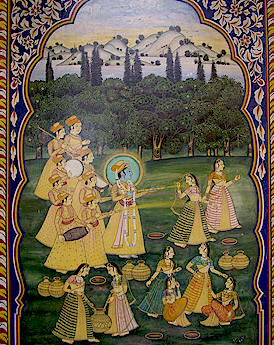
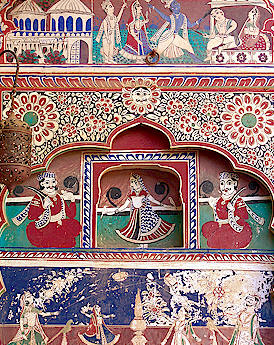
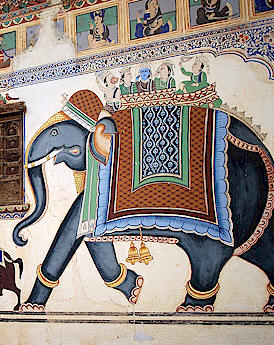
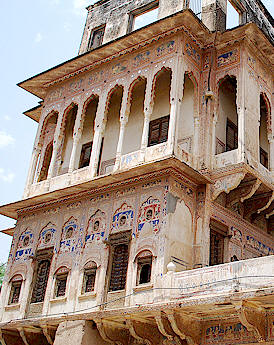
  |
